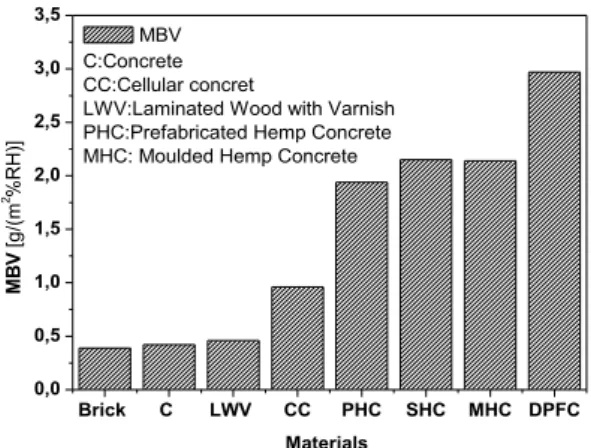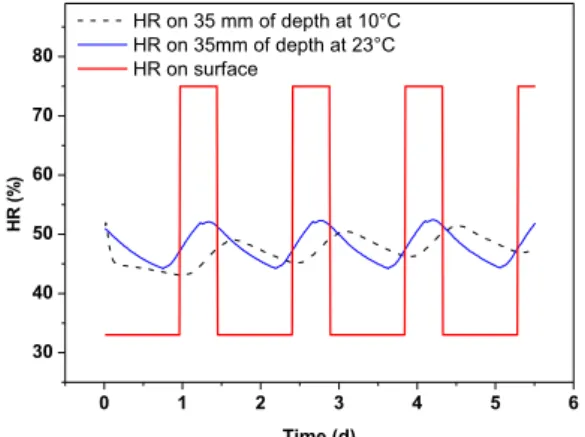EcoGRAFI
2ndInternational Conference on Bio-based Building Materials& 1st Conference on ECOlogicalvalorisation of GRAnular and FIbrous materials June 21th - 23th 2017
Clermont-Ferrand, France
445
HYGROTHERMAL BEHAVIOR OF A DATE PALM CONCRETE
N. Chennouf1,2,3*, B. Agoudjil1, A. Boudenne3, K. Benzarti4, Fathi Bouras2 1 LPEA, Université Batna 1, Les Allées 19 Mai Route de Biskra Batna, Algérie2 University Echahid Hamma Lakhdar ElOued, PO Box 789 ELOued, Algérie 3 CERTES, Université Paris Est Créteil Val de Marne, France 4IFSTTAR - Département Matériaux et Structures, Marne-la-Vallée, France
*Corresponding author; e-mail: nawal.chennouf@u-pec.fr
Abstract
The environmental quality of a building generally aims to take into account both the stakes of sustainable development, social and economic. For these reason, several researchers are recently interested to introduce the biobased materials for the new and renovated buildings to reduce simultaneously energy consumption, gases emission and agricultural production. Studies carried out on new biobased building materials, which contains date palm fibers (DPF), have showed their both thermal insulation efficiency and mechanical reliability. In order to characterize the behavior and the effectiveness of this material both in terms of energy saving and indoor environmental quality. We have focused our investigation on the study of the hydric behavior of DPF concrete. The buffer moisture was estimated on the outdoor environment at isothermal condition according to the NORDTEST method then at non-isothermal condition. The results showed that the DPFC could be classified as an excellent moisture and heat regulator thanks to its absorption capacity and low thermal conductivity.
Keywords:
Moisture transfer, thermal inertia, date palm concrete
1 INTRODUCTION
To ensure comfort in a building, the relative humidity of the surrounding air is an important factor and is widely depend on the thermal and the hydric properties of building materials. The use of the Hygroscopic materials such as wood and wood based materials that absorb and release moisture as insulation and surface moisture buffering materials can be used to positively reduce the extreme deviations between moisture levels within the wall due to their low thermal conductivity and high moisture capacity (E. Latif 2014), an effective means of stabilizing the humidity without consuming energy and thus ensuring a satisfactory level of comfort. In these framework this work is devoted to dynamic characterization of hydric behavior of new material based on concrete reinforced with green material which is the date palm wood. As the hygrothermal performance is not only affected by the moisture properties and the sorption history, such as sorption isotherm but also temperature dependent, this paper dedicated to investigate the moisture buffer performance of Date Palm Fibers Concrete (DPFC) according the Nordest project, were the distribution of moisture is monitored at different depths of the sample tested under tow temperature firstly at 23°C then at 10°C.
2 MATERIALS
In this study, the specimens are obtained according to the following technique: a mixture of the cement, sand and fibers are stirred dry, and then the water is added gradually. Here the material contains with portions concentrations as follow: 62%, 23% and 15% respectively (N. Benmansour 2014). Then, the mixture is versed into cubic molds. After one week, the samples are demoulded and let dry two months in the open air.
The dry mixture and the samples of DPF concrete are shown in Fig. 1.
Fig.1: The dry mixture and the samples of DPFC.
3 METHODS
3.1 Moisture buffer value
To characterize the ability of the DPF concrete to buffering (store and release) the moisture of the
ICBBM & ECOGRAFI 2017
446 surrounding air; we use in these paper the method defined by the Nordest project (C. Rode 2005). Nordest project like many others standards determined an experimental set up where the sample is exposed to cyclic step-changes in RH between high (75%) and low (33%) values for 8 and 16 hours respectively at constant temperature. In this paper, we used two temperatures firstly at 23°C then at 10°C.
For the MBV measurements, parallelepiped samples (95 x 65x 60mm) thicker than the moisture depth penetration are sealed on five sides with aluminum to insure the 1D transfer with an open surface (see Fig.
2).
The sample is placed in a climatic chamber (Memmert HPP 750) and conditioned at 23°C and 50% HR until to reach a variation less than 0.1 % of the weight. The temperature and the relative humidity were monitored at depth of 35mm with temperature and relative humidity sensors (DKRF400 Series).
Fig.2: The experimental device for evaluating moisture buffering of DPFC.
The MBV value is calculated at a steady state according to the following Eq. (1):
(1) With MBV: moisture buffer value (kg/(m2%RH)), Δm:
moisture uptake/release during the period (kg), A: open surface area (m2), RH
high/low: high/low relative
humidity level .
4 THEORY
The experimental step was followed by the determination of the ideal MBV. This buffer property represents a dynamic characteristic defined also by Nordest project, is calculated using the moisture effusivity which are determined under steady state and equilibrium conditions (C. Rode 2005) Eq. (2) and (3):
(2)
bm in a similar way to the definition of thermal effusivity, we can describe the ability of a material to absorb or release moisture [kg/(m²Pa·s½)].
(3)
The penetration depth represents the depth where the amplitude of moisture content variation exceed 1% of the surface amplitude is calculated using Eq. (4) :
(4)
Where Dw is the moisture diffusivity of the material,
tp(24hours) time period.
5 RESULTS
Results show that DPF concrete exhibits a very good moisture buffer capacity. Is classed an excellent regulator of humidity using the Nordest classification (C. Rode 2005). It can be seen that the highest MBV was achieved for PDFC (2.97 g/(m2%RH)) followed by
the other biosourced materials found in the literature
(Fig. 3). Common building materials as the concrete,
brick showed the lowest value for MBV (Fig. 3).
Fig.3: Moisture buffer value classes of studied material with other materials tested in literature (C. Rode 2005;
F. Collet 2013).
If the experimental results are explored in terms of adsorption isotherm, the high moisture adsorption capacity of DPFC is 2.1 × 10-9 m2s-1 (B. Haba 2016),
this is also reflected in their corresponding MBV values, these results represents advantageous in terms of controlling internal relative humidity and minimizing interstitial condensation in an environment with cyclic variations of relative humidity.The difference between the weight changes during cycles becomes less than 5% between the second cycle and the third one (Fig. 4). There is a significant difference between the behavior of the sample at 23°C and 10 ° C.
Fig. 4: Moisture uptake and release at T=23°C and T=10°C and relative humidity in the climatic chamber
for 5 cycles.
Were the weight of the same sample increase with decrease of the temperature, then the amount of weight uptake and (Av.Δmsor)and release (Av.Δmdes)
Brick C LWV CC PHC SHC MHC DPFC 0,0 0,5 1,0 1,5 2,0 2,5 3,0 3,5 C:Concrete CC:Cellular concret
LWV:Laminated Wood with Varnish PHC:Prefabricated Hemp Concrete MHC: Moulded Hemp Concrete
M B V [ g /( m 2%RH )] Materials MBV 0 1 2 3 4 5 6 7 337,2 337,4 337,6 337,8 338,0 338,2 338,4 338,6 338,8 339,0 Weight at 23°C Weight at 10°C HR Time (d) W e ig h t( g ) 30 40 50 60 70 80 90 H R (% )
HRhigh HRlow
A m MBV s p m p w b
.
p w pt
D
d
,1%
4
.
61
.
p m s ideal p b t MBV 0.00568. . .ICBBM & ECOGRAFI 2017
447 under non-isothermals condition is not closed as it’s showed in Table 1.
Table 1: Weight uptake and release.
T=23°C T=10°C
Av.Δmsor 0.787 0.546
Av.Δmdes 0.630 0.445
For each temperature, the water buffer value is calculated in absorption, desorption and average from cycles 3 to 5, the results are given in Table 2.
Table 2: Moisture buffer value in adsorption, desorption and average for DPFC.
Temperature 23°C 10°C MBV- adsorption [g/(m2%RH] 2.96 2.03 MBV- desorption [g/(m2%RH] 2.98 1.97 MBV- average [g/(m2%RH] 2.97 2.00
It can be seen that the MBV value decrease with the decreasing of temperature. When the temperature goes from 23°C to 10°C, MBV-average decrease from 2.97 [g/(m2%RH] to 2.00 [g/(m2%RH] (a variance of
32.56%) these variance is approximately closed for MBV in adsorption and desorption phase. The same results in which the moisture buffering capacity decrease as function of the temperature has been observed by Mazhoud et al. (Brahim Mazhoud 2015) for two hemp-lime plasters but with variance between 59% and 54%. These decreasing is completely logical because the MBV [g/(m2%RH] is calculated from the
relative humidity value which depends on temperature
Tale 3 shows the value of MBVideal and penetration
depth deduced based on experimental results obtained by Haba et al. (B. Haba 2016).
Table 3: MBVideal,dP.1%, bm , Dw of DPFC. Dw [m2/s] bm [kg/m2.Pa.s1/2] MBVideal [g/m2.%RH] dP.1% [cm] DPFC 2.1x10-9 8.07x10-7 3.79 3.5
These values represent a referential values, it has been calculated assuming sinusoidal variation, while the Nordtest protocol uses exposures change. It can be only considered as an approximation. For the penetration depth, the experimental studies showed that indeed the depth where the amplitude of moisture content variation does not exceed 1% of surface amplitude as presented in Fig.5.
At 35 mm, the sample had not affected by the cyclic variation in term of humidity. This result shows a greater reduction of the amplitude. Unlike the other materials where the amplitude of the cycles of MBV test is not reduced to a higher depth as it is shown by Lelievre et al for the case of hemp concrete (C. Rode 2005).
6 CONCLUSION
In the present work, we have investigated experimentally the hygrothermal behavior of DPF
concrete at the material scale. We have notice that these new bio based materiel exhibit an excellent moisture buffer value. This paper provides also some information concerning the effects of temperature. These effects were assessed experimentally on the moisture buffer value at 10°C and 23°C. The results showed that a decrease of temperature results a decrease of moisture buffer value of DPFC.
Fig.5: Measured relative humidity and temperature at surface and at the middle of the PDF concrete sample
during the MBV test.
7 ACKNOWLEDGMENTS
This research was conducted with financial support of PHC TASSILI Project 16MDU976.
8 REFERENCES
Brahim Mazhoud, S. P., Florence Collet, Julien Chamoin (2015). "Hygric and thermal properties of hemp lime plasters." Building and Environment. C. Rode, R. P., H. Lone, B.Time, A.GustavsenT. Ojanen, J. Ahonen, K. Svennberg (2005). Moisture Buffering of Building Materials, Department of Civil Engineering,Technical University of Denmark.
Eshrar Latif, S. T., Mihaela Anca Ciupala, Devapriya Chitral Wijeyesekera, Darryl Newport (2014). "Hygric properties of hemp bio-insulations with differing compositions." Construction and Building Materials ( 66): 702–711.
Florence Collet, J. C., Sylvie Pretot, Christophe Lanos (2013). "Comparison of the hygric behaviour of three hemp concretes." ( 62): 294–303.
Haba B, C. N., Boudenne A, Agoudjil B (2016). Experimenta study of hygrothermal proerties of Date Palm Concrete. Congress Energy and Environment Knowledge Week, Paris. FRANCE.
M. Rahim, O. D., A.D. Tran Le, G. Promisa, B. Laidoudi, A. Crigny,B. Dupre, T. Langlet (2015). "Characterization of flax lime and hemp lime concretes: Hygricproperties and moisture buffer capacity." Energy and Buildings(88): 91–99.
Nadia Benmansour, B. A., Abdelkader Gherabli, Abdelhak Kareche,Aberrahim Boudenne (2014). "Thermal and mechanical performance of natural mortar reinforcedwith date palm fibers for use as insulating materials in building." Energy and Buildings(81): 98-104. 0 1 2 3 4 5 6 30 40 50 60 70 80 H R ( % ) Time (d) HR on 35 mm of depth at 10°C HR on 35mm of depth at 23°C HR on surface

